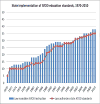State-level education standards for substance use prevention programs in schools: a systematic content analysis
- PMID: 24016749
- PMCID: PMC3947729
- DOI: 10.1016/j.jadohealth.2013.07.020
State-level education standards for substance use prevention programs in schools: a systematic content analysis
Abstract
Purpose: Three fourths of public schools in the United States maintain instructional programs to discourage alcohol, tobacco, and other drug (ATOD) use. State-sanctioned instructional standards attempt to direct this ATOD preventive education. No existing research, however, systematically codes these standards across all grades and states. We performed such an analysis.
Methods: We retrieved ATOD standards information from all 50 states and the District of Columbia from multiple sources, including the National Association of State Boards of Education's State School Health Policy Web site. Three independent researchers classified and cross-validated ATOD standards (inter-rater agreement = 98%) based on recommended content domains and pedagogic delivery methods.
Results: We find substantial grade-level variation in standards. Elementary schools emphasize generic social skills and affective skills, whereas middle and high school standards focus on knowledge about biological and behavioral consequences of ATOD use. States also vary widely in their content and coverage of standards. Two thirds of states do not include standards in all content areas considered "evidence-based."
Conclusions: The ATOD curricular agenda for the majority of states falls well below recommended content and delivery benchmarks. We intend for our harmonized data set-the first of its kind-to promote research that examines the relation among state ATOD standards, actual classroom instruction, and adolescent ATOD use.
Keywords: Alcohol; Illicit drugs; School-based education; State standards; Tobacco.
Copyright © 2014 Society for Adolescent Health and Medicine. Published by Elsevier Inc. All rights reserved.
Figures



References
-
- Toumbourou JW, Stockwell T, Neighbors C, Marlatt GA, Sturge J, Rehm J. Interventions to reduce harm associated with adolescent substance use. Lancet. 2007;369(9570):1391–1401. - PubMed
-
- Centers for Disease Control and Prevention (CDC) Youth Risk Behavior Surveillance — United States. MMWR. 2011;61(4):1–162. - PubMed
-
- NCASA: National Center on Addiction and Substance Abuse. Shoveling Up II: The Impact of Substance Abuse on Federal, State and Local Budgets. 2009;47 Retrieved from: http://www.casacolumbia.org/articlefiles/380-ShovelingUpII.pdf.
-
- Miller T, Hendrie D. In: Substance Abuse Prevention Dollars and Cents: A Cost-Benefit Analysis. 07-4298 DPNS, editor. Rockville, MD: Center for Substance Abuse Prevention, Substance Abuse and Mental Health Services Administration; 2008.
-
- Gorman DM. The Best of Practices, the Worst of Practices: The Making of Science-Based Primary Prevention Programs. Psych Services. 2003;54(8):1087–1089. - PubMed
Publication types
MeSH terms
Grants and funding
LinkOut - more resources
Full Text Sources
Other Literature Sources
Medical

